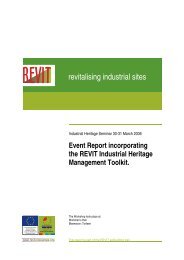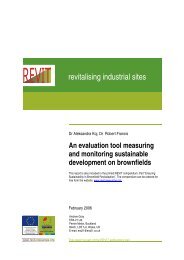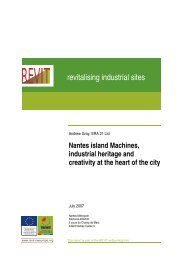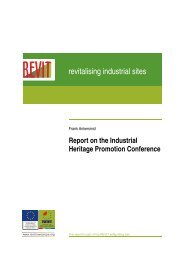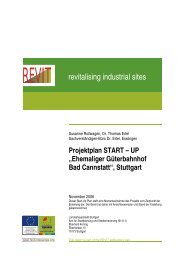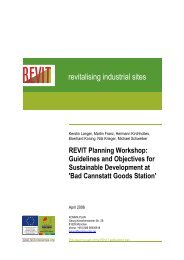REVIT Heritage Report.pdf
REVIT Heritage Report.pdf
REVIT Heritage Report.pdf
You also want an ePaper? Increase the reach of your titles
YUMPU automatically turns print PDFs into web optimized ePapers that Google loves.
Torfaen County Borough Council<br />
<strong>REVIT</strong>: A Review of the Conservation of Industrial <strong>Heritage</strong> Assets on Brownfield Sites<br />
4.3 Medway<br />
Introduction<br />
4.3.1 Medway Council, is located in Kent in southeast England. The impetus for<br />
regeneration in Medway was the closure of the Royal Navy’s dockyards and<br />
associated sites in 1984. This caused large areas of Brownfield land along the<br />
River the Medway to become vacant, many containing large numbers of<br />
historic sites and monuments. A further spur to this process was the<br />
designation of Medway as a growth area within the Thames Gateway which<br />
resulted in the creation of the Medway City Estate as an enterprise zone. To<br />
set out their ideas for the regeneration of the area, Medway Council together<br />
with the Medway Renaissance Partnership published set out their aspirations<br />
in Medway’s Waterfront Renaissance Strategy (Medway 2004).<br />
4.3.2 As part of Medway’s Waterfront Renaissance scheme there has been a<br />
systematic programme of public and private investment which has helped to<br />
rebuild the local economy. Medway Council has begun with the economic,<br />
physical and social regeneration of Brownfield sites such as Chatham Historic<br />
Dockyard through a heritage-led approach, which draws on the “museum<br />
process” similar to Torfaen, but also emphases a greater degree of mixed use<br />
in the form of business and residential development.<br />
4.3.3 The regeneration of Chatham Dockyard was assisted by a £12.3m grant from<br />
<strong>Heritage</strong> Lottery Fund which has paid dividends in terms of businesses,<br />
employment and tourism as well as the wider regeneration implications for the<br />
Thames Gateway area. Research by the Southern Tourist Board concludes<br />
that the Historic Dockyard is worth £20 million for the local economy.<br />
4.3.4 This Brownfield site contains a significant number of historic buildings,<br />
maritime industrial features and archaeological sites which have been<br />
highlighted as the centre of the strategy for regeneration of the site.<br />
Chatham Historic Dockyard<br />
4.3.5 The Historic Dockyard is a 32 hectare site with over 100 surviving historic<br />
buildings and maritime structures. The majority of the historic features were<br />
constructed between 1704 and 1855 and were built to maintain the sailpowered,<br />
timber hulled warships of the Royal Navy. A total 47 of these<br />
buildings and sites are protected as Scheduled as Ancient Monuments with 53<br />
being also listed as Historic Buildings, consisting of eleven Grade I Listed and<br />
33 Grade II* Listed Buildings.<br />
4.3.6 During the mid-17th century the Chatham Historic Dockyard was the Royal<br />
Navy’s main shipbuilding and repair yard and retains a unique range of historic<br />
naval structures including storehouses, dry docks, rope walks and covered<br />
slipways. The Historic Dockyard is the most complete surviving example of a<br />
former Royal Dockyard in Britain and together with Fort Amherst and the Lines<br />
site has been proposed for World <strong>Heritage</strong> Site status.<br />
4.3.7 As part of the process of managing and conserving the site an independent<br />
Chatham Dockyard Historic Charitable Trust was set up. A programme of<br />
repair and refurbishment of various buildings was carried out which has<br />
created a mixed-use site which is a successful tourist destination with small<br />
businesses and shopping outlets. The proposed uses for the site consisted of<br />
leisure and tourism, small business development and display of Medway’s<br />
0014021/JM/001 26




